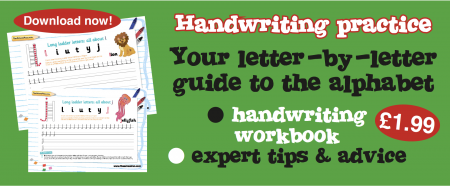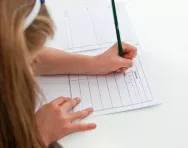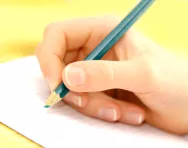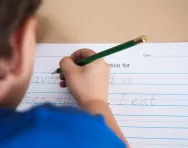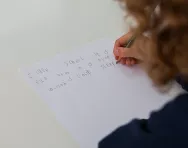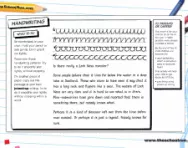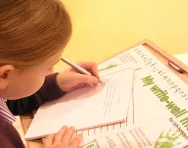TheSchoolRun.com closure date
As we informed you a few months ago, TheSchoolRun has had to make the difficult decision to close due to financial pressures and the company has now ceased trading. We had hoped to keep our content available through a partnership with another educational provider, but this provider has since withdrawn from the agreement.
As a result, we now have to permanently close TheSchoolRun.com. However, to give subscribers time to download any content they’d like to keep, we will keep the website open until 31st July 2025. After this date, the site will be taken down and there will be no further access to any resources. We strongly encourage you to download and save any resources you think you may want to use in the future.
In particular, we suggest downloading:
- Learning packs
- All the worksheets from the 11+ programme, if you are following this with your child
- Complete Learning Journey programmes (the packs below include all 40 worksheets for each programme)
You should already have received 16 primary school eBooks (worth £108.84) to download and keep. If you haven’t received these, please contact us at [email protected] before 31st July 2025, and we will send them to you.
We are very sorry that there is no way to continue offering access to resources and sincerely apologise for the inconvenience caused.
Handwriting practice: what all parents need to know
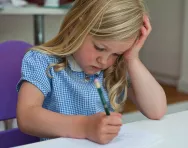
Handwriting isn’t just learning the alphabet – fine motor skills, hand eye co-ordination and an interest in putting pen to paper are essential as your child develops their handwriting skills. The final goal is for handwriting to become an automatic skill, so your child can concentrate on what, and not how, they are writing.
How handwriting develops by age
All children learn to write at a slightly different pace, but as a general guide research suggests that handwriting skills develop in these stages:
| Child's age | Handwriting level |
| 1 year | Can scribble on paper |
| 2 years | Can make horizontal, circular and vertical marks on paper |
| 3 years | Can copy horizontal, circular and vertical lines |
| 4-5 years (Reception) | Can use a pencil and hold it effectively to form recognisable letters, most of which are correctly formed |
| 5-6 years (Year 1) | Can form lower case and capital letters Can form digits 0 to 9 |
| 6-7 years (Year 2) | Can use the strokes needed to join letters Can write capital letters, lower case letters and digits that are all the correct size in relation to each other |
| 7-9 years (Years 3 and 4) | Can use the strokes needed to join letters Increasing the legibility, consistency and quality of their handwriting |
| 9 to 11 years (Years 5 and 6) | Can write legibly, fluently and with increasing speed |
Correct posture and sitting position for handwriting
Before your child even picks up a pencil make sure they are sitting comfortably at a table.
- Their feet should rest firmly on the floor.
- They should be sitting back in their chair so their hips touch the back of the chair.
- Their forearms should be resting on the table.
- They should be facing the table squarely.
Preparing for handwriting
There’s lots you can do to prepare your child to write, including games that help develop fine motor skills.
If they’re happy to pick up a pencil and get writing, start with patterning – our handwriting pattern worksheets offer lots of practice in push pattern movements, pull pattern movements, vertical pattern movements, diagonal pattern movements and ‘c’ pattern movements – all very satisfying when armed with a favourite pencil!
Writing letters and numbers
Ready to start practising letter formation? It’s useful to show your child the letters of the alphabet divided into ‘movement groups’.
“The letters of the alphabet can be divided into groups according to the movement made to start writing the letter,” explains Gwen Dornan of the National Handwriting Association. “Each group has a lead letter – L for Long ladder letters, C for Curly caterpillar letters, R for One-armed robot letters and Z for Zig-zag monster letters.”
It’s important to note than some schools use different shapes for some letters (b, f, g, j, y and k are the commonest letters with variations). For example, y can be taught as a curvy letter (like a u with a tail) or as a straight-lined letter (where the letter is made up of diagonal strokes only). Always check your school’s handwriting policy and ask to see an example alphabet so you can help your child practise letters the same way at home and at school.
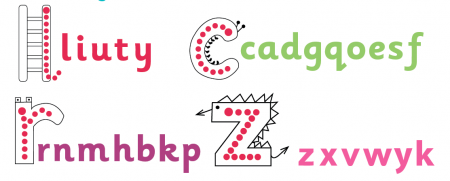
The way handwriting is taught varies hugely from school to school.
Even in Reception some schools use an entry stroke that starts on the base line (the line your child is writing on) to begin each letter and prepare children for joined-up handwriting from the beginning of primary school. Again, it’s important for your child to practise their school style at home, so if your child’s school uses this method with their age group you should amend any handwriting worksheets and practice materials by drawing the entry strokes at the beginning of each letter yourself.
Find more handwriting practice tips and handwriting dos and don’ts on the site. If your child has been writing for a while and you’re looking for ways to improve their handwriting follow our 5 steps to success in developing handwriting, try a few exercises to help with common handwriting problems or download our step-by-step subscriber-only learning pack, Improve your child’s handwriting in 8 weeks.
For hands-on practice browse through our handwriting worksheets, developed with the support of the experts at the National Handwriting Association, or try our 8 great handwriting activities.
